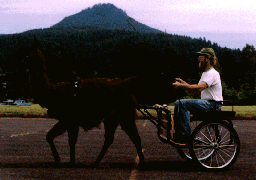Llama care, management and resources
- Llama FAQ
- Llama literature
- Basic care
- Castration
- Spaying
- About breeding llamas
- Handling young llamas
- Misdirected territorial aggression
- How old should llamas be for training and work?
Driving llamas in harness
Fiber from llamas
Llamas
as guardians
Classic performance llamas
Communicating
Our llama family
Just for fun
Cria photos
Training consultation
Performance
llama analysis
If you don't rescue ... DON'T BREED!
Driving Llamas

Originally, Gwen taught Ranger Dusty to drive as an additional means of conditioning him for packing. Dusty liked it so much that driving has become another way we enjoy our llamas.
Currently, llama driving is most often seen as a curiousity class at shows. What is particularly curious is that the llamas usually wander vaguely about -- if they move at all -- and frequently look contorted, uncomfortable, and unnatural. After viewing one of these controlled disasters, many people come away with the idea that llamas are not really driving animals. We certainly used to think so. However, we had seen one very good driving llama who moved out well, was quite comfortable, and certainly looked like a cart was part of his natural repertoire. We set about to uncover the reasons why most llamas do so poorly, ended up redesigning equipment and adjusting our training methods, and can now say that we have successfully addressed most, if not all, of these issues.
Where do we drive llamas? On the road (if it's not too busy), at the nearby state park, on bike paths, at virtually any fairgrounds we visit for shows, and -- for show practice -- in the usually-empty parking lot of a nearby county park and boat ramp. Dirt roads are fun, too, although impassable in this climate for part of the year. Gravel makes such roads passable, but large rock (the material of choice for most unpaved public roads in our area) bruises llama feet, and so we don't use those unless the llamas will only be walking. Forest and grassland trails are wonderful if wide enough and not too soft, but blackberry thorns make these a bad choice for carts with pneumatic tires!
Conditioned, well-built driving llamas can trot for miles, and if properly worked by cantering for about 50% of their outing, can usually use up the available roadway and your time before tiring. Even a less-well-endowed llama with good equipment, proper conditioning, and proper working practices can take you for a pleasureable drive of several miles.
Gender is not an important issue for a driving llama. We drive open and pregnant females, geldings, and studs (who, if they couldn't behave in harness, would no longer qualify for our breeding program!). Sahalie is eager to drive when pregnant until about one month before parturition, and she happily returns to the road when her baby is a month old and can afford for her to be gone for a couple of hours.

Like all things, driving is not for everyone or every llama. There's equipment to transport -- simple enough to do alone if well-designed attachments for the cart can be put on your vehicle, but nigh unto impossible otherwise. Some locations just don't have a decent area to drive in within a reasonable distance. Some llamas simply don't like the effort involved, are too herd-bound for use as a pleasure driving animal, or are too violent and/or unpredictable to be safe in harness. And some llamas are physically unsuitable and can incur serious damage from driving.
Showring driving is an advanced endeavor and, quite frankly, training for show driving classes isn't very exciting. It's no wonder that most llamas in driving classes don't look happy or act like they know what they're up to. We have had good success concentrating instead on actually driving, which we and our llamas enjoy, and leaving the artificial show stuff for later.
Equipment:
- Carts (two-wheeled training and utility vehicles)
- Driving Halters
- Harnesses
Articles:
Return to Lost Creek Llamas home page